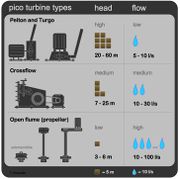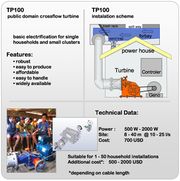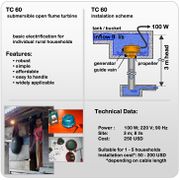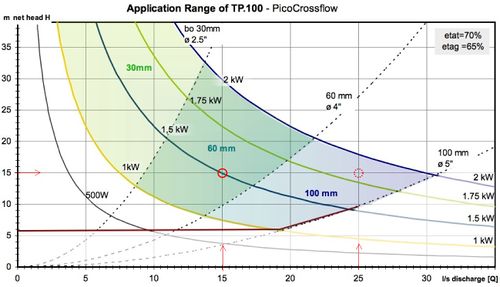Knowledge fuels change
For over a decade, Energypedia has shared free, reliable energy expertise with the world.
We’re now facing a serious funding gap.
Help keep this platform alive — your donation, big or small, truly matters!
Thank you for your support
Pico Hydro Power
Introduction
Pico hydro power: Turbines smaller than 10 kW are usually called "pico". Pico hydro power is rarely fed into a power grid, but in most cases electricity is delivered to a village or a workshop. As there are varying definitions of the power range of of "micro" and "pico", it is advantageous to specify each project's power output in kW.
Concept
Pico hydropower is the only form of small renewable energy production which works continuously without battery storage. Where applicable it is the most cost efficient solution to supply electrical energy. Pico turbines can provide power for small clusters or even single households
Individual hydropower supply cuts out the efforts of organising a community. Identifying, planning and managing takes a higher proportion of the whole installation efforts as smaller a sites becomes. For less consumers served, specialists have similar efforts in accessing sites. On the other hand small installation are more likely to be "do it your self".
With guidance by info materials and advise from a local shop consumers could be enabled to install their own pico turbine. If pico hydropower can become an "over the counter" product it meets a immense demand.
One example may be the north of Laos where cheap Chinese pico-turbines flooded the country in ten-thousands or more.
Requirements:
- suitable locations
- accessibility of affordable equipment (turbines) and installation know how
Electricity has a high value so working systems will spread quickly.
In many countries self-made solutions can be found, whereby a wooden water wheel is coupled with a car-alternator to produce electricity. Professional solutions increase efficiency reliability and safety.
Pico Hydro Turbines
Principles of Turbines for high, medium and low head conditions
|
Each type of turbine has its own features.
The main characteristic it's the turbines suitability for different heads and different amounts of water (see picture left).
In general a Crossflow turbine has the wides application range and is very tolerant against debris in water.
"Self made" Pico turbines usually are waterwheels or propeller turbines. The concept of pressurised pipes over high heads seems not to be common sense. One reason may be that channeling water towards a deep drop requires abstraction of existing landscape. It cannot be seen from a single standpoint. Informative materials may help to raise awareness for such potentials.
|
Experiences with Certain Pico Turbines
|
TP100
► Factsheets on site installations in Indonesia: SalulombeandGarumpar |
| ||||||
|
TC60 (100 W)
*depending on length of transmission cable |
Chances and Challenges
Advantages:
- Cheapest technical solution for independent power supply.
- Clean, sustain-/ renewable energy resource.
- Reliable => long lifetime as it is based upon robust mechanical techniques.
- Minimal running and follow up costs (unlike batteries at PV systems).
- Small maintenance efforts, which are easy to follow.
Disadvantages:
- Site specific power output => pre-feasibility check required.
- Site specific installation => basic hydro know-how required.
- All cost are investment cost => upfront.
- Mostly shared connections => require community organised operation, management and use of water resources.
- Difficult access of clients => requires hubs and/or supply structure.
Capacity
Power output is limited by local conditions of height and amount of water available. Turbines are chosen by site conditions.
The following is an example for one specific turbine designed in Indonesia.
Explanation:
The colored lines indicate the power output at certain height/flow situations. The red horizontal line such turbine is technically not feasible, the blue "2 kW" line indicates a tech. maximum (for this specific turbine). The dotted lines separate three areas wherein turbines have certain sizes (30, 60 and 100 mm wide).
Example: at a site with 15 m height difference and a flow of 15 l/s the turbine can produce 1.5 kW (it will have a width of 60 mm). If on the same site (15 m) 25 l/s flow, power output will be 1.8 kW.
Remark:
to produce the same electric power by photovoltaic you require about 50 m2 PV-panels (and min. 20 batteries).
Pico Hydro Materials
- Pump as Turbine
it is possible to use water pumps "backwards" as turbines. Advantages is a wide availability also from spare parts.
► Manual how to plan a site by using a Pump as Turbine (PaT)
- A Buyers Guide
Canadian brochure of 56 pages. Containing general information about: planning, components, costs, examples and turbine producers of hydropower installations ranging from 200 W - 15 kW.
► "A Buyers Guide" a nice overview, easy understandable.
- Pico hydropower attempts, MHPP, Indonesia, 2007-08
A consolidation of the Pico hydropower efforts in Indonesia during 2007-08. Especially the results on a feasibility research on Family hydro units. An approach to spread turbine technology for single households or very small clusters of users.
► MHPP's Pico Component 2007-08 (pdf)
- 'Pocket Hydro – 'a mini power plant for decentralized electric power
Ongoing project with the aim to provide affordable electric lighting through the use of local water energy in remote rural areas.
Further Information
References























